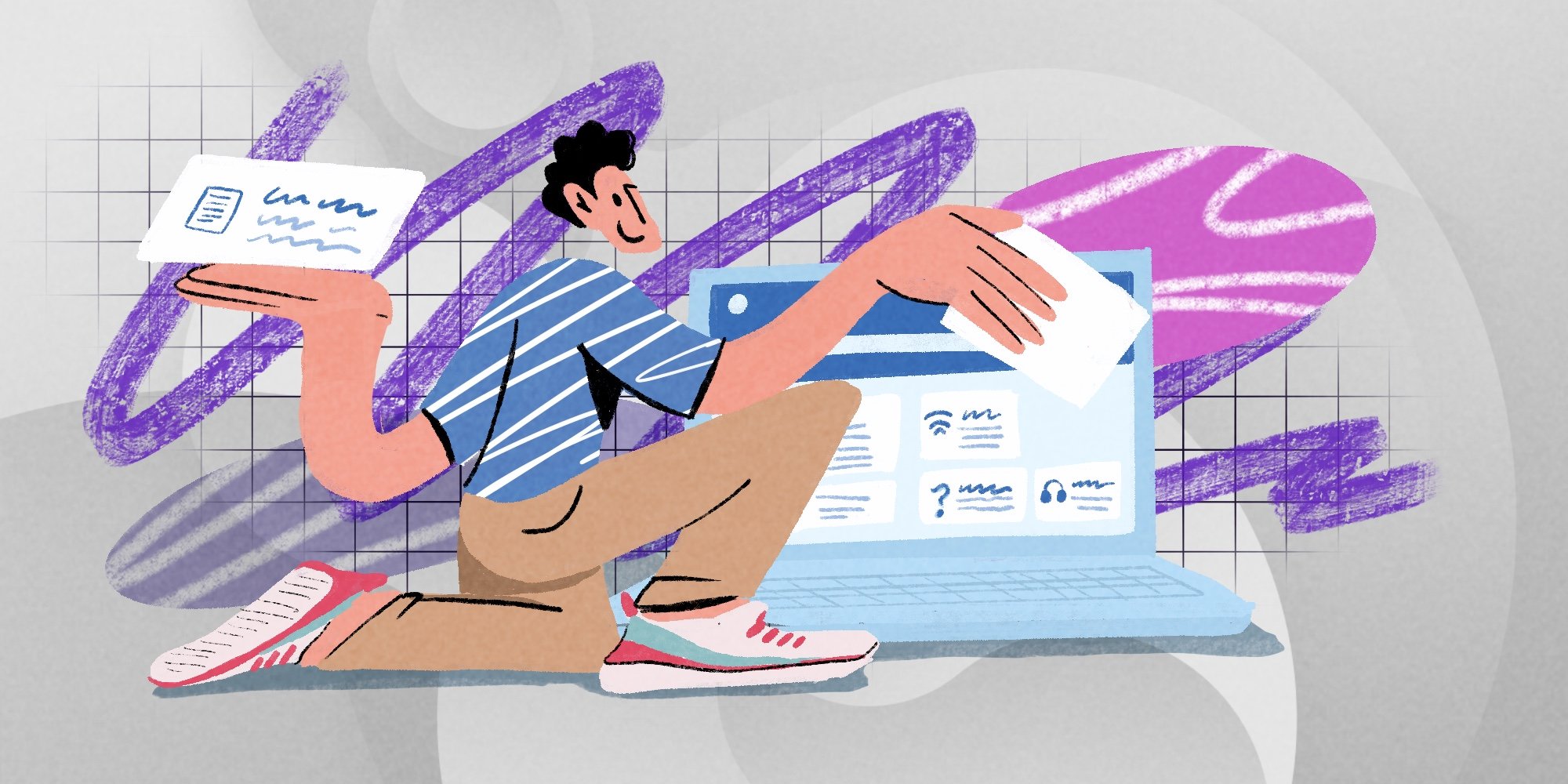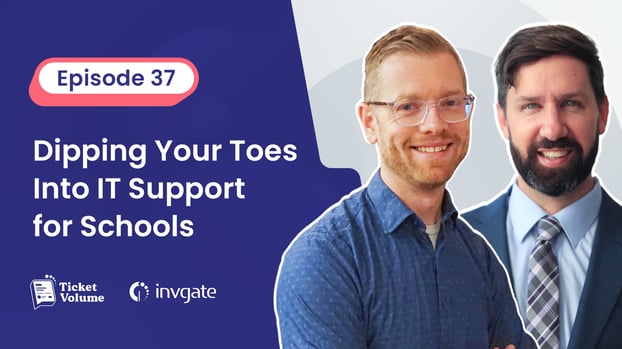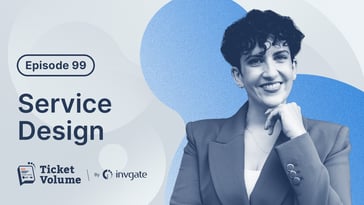IT is a field that brings numerous challenges and complexities to educational institutions. We rely heavily on technology to enhance teaching and learning experiences, so it is crucial to have dedicated professionals who understand the unique requirements of this sector.
On the 37th Episode of Ticket Volume, our IT podcast, Casey Rutherford shared his expertise in Innovation in Educational Technology, assisting teachers with new technologies, integrating platforms, and automating processes. His insights will provide valuable guidance for anyone involved in educational IT.
Casey Rutherford, currently serving as the Director of Educational Technology and Innovation at Faribault Public Schools, has a true passion for teaching. With a background as a Physics and Math teacher for 16 years, his expertise and dedication to education are unparalleled.

Make sure you don't miss out on the opportunity to listen to the entire episode and learn more from Rutherford's expertise. Don't forget to mark your calendar for our monthly live recordings as well. By registering today, you'll have the chance to gain valuable insights, ask real-time questions, and broaden your understanding.

IT Automation at Inver Grove Heights Schools
Casey Rutherford serves as a bridge between the technology team and teachers, understanding the diverse needs and perspectives in education. Input from stakeholders such as special education directors and teachers is crucial. Custom apps are often necessary to meet specific teacher requirements, and student privacy laws can sometimes hinder educational initiatives.
To improve IT, he implemented a new system called Incident IQ for the service desk, which integrates with the student information system and streamlines processes. Automation through Incident IQ has been implemented within the last six months, allowing for seamless app requests and transfers to technicians.
|
|
"So now a teacher can go in and say ‘hey Johnny is having a problem with his iPad’, she clicks on Johnny, it pulls up his iPad, then she can submit a ticket and we can then go in and remotely check out that iPad within seconds as opposed to the old system. (...) Just really streamlined a lot to pull all those things together, customization abilities." Casey Rutherford |
At the elementary level, teachers often act as intermediaries between students and IT support, reporting issues on behalf of students. Right now, the IT support system is being expanded to automate onboarding processes for new staff, facilitated by the integration of different platforms.
Overall, Rutherford's experience highlights the importance of considering diverse perspectives in education, balancing individual needs, and streamlining processes through automation to provide effective IT support in schools.
8 ways of using technology to improve learning outcomes
|
|
"We have one core system which is Infinite Campus. It's kind of the standard for a lot of schools, and we input some basic information in there and that triggers an IDM system called Clever, - that is again school specific - that will create an account for the person it syncs, to ad which thinks to Google, which sings to everything else. So we just enter a name, a username, an ID number, and everything goes from there. (...) This year the project has been ‘let's automate’, let's get to the point where basically if somebody says ‘hey we need this account created’, we have it done in usually minutes." Casey Rutherford |
Now, from automated account creation to syncing processes, educators and administrators are constantly exploring new ways to leverage technology for improved learning outcomes. Rutherford delved into the significance of comparison reports, effective communication methods, and the need for adaptation and critical thinking when utilizing educational technology. Here are some examples of how schools can take advantage of technology:
1. Comparison reports for syncing
One crucial aspect of syncing processes is the utilization of comparison reports. These reports play a vital role in ensuring accuracy and preventing potential issues such as duplicate accounts or unintended modifications. He advice was to review changes before executing them, so educators and administrators can identify discrepancies between expected outcomes and actual changes. This proactive approach saves valuable time, prevents confusion, and reduces the need for HR calls post-sync.
2. ETL: A middle moment for review and fixing
Export, Transform, Load (ETL) serves as a middle moment in the syncing process. It allows for a comprehensive review of changes and provides an opportunity to fix any potential errors before final execution. By embracing ETL, education professionals can ensure a smoother syncing process, minimizing disruptions and maximizing efficiency.
3. Effective communication methods in the industry
Communication plays a pivotal role in the successful implementation of educational technology. Physical in-person meetings, virtual options, and listservs are commonly used to foster collaboration among professionals. While Slack channels have gained popularity, listservs remain the preferred choice among older professionals. These platforms facilitate knowledge sharing, problem-solving, and the exchange of ideas, ultimately enhancing the overall educational experience.
4. Email conversations and archiving
Email conversations serve as a valuable tool for discussing challenges, anticipating problems, and seeking solutions. These conversations are often archived for future reference, creating a repository of knowledge. The ability to search through these archives enables educators and administrators to access past discussions on specific topics, empowering them to make informed decisions based on historical insights.
5. A limited number of professionals
Due to the limited number of professionals in similar roles, communication often occurs at a higher level. This fosters a sense of community and encourages the sharing of stories and experiences. Platforms like the subreddit for K-12 sys admins provide a space for professionals to connect, learn from one another, and collectively navigate the challenges unique to their roles.
6. Embracing educational technology
The use of technology in education is rapidly evolving, requiring educators to adapt and grow alongside it. Tools like Photomath and Wikipedia have become indispensable for students, transforming the way they learn and research. As education professionals, it is essential to understand and utilize technology to enhance learning rather than restrict or control it. Similar to the initial resistance faced by calculators in the past, embracing technology opens up new possibilities for advancing education in the 21st century.
7. Using technology tools for critical thinking
While educational technology offers tremendous benefits, it is crucial to use tools effectively and critically evaluate their output. Chat GPT, for instance, is a powerful tool that can be utilized in various ways. However, blindly accepting its output as truth can hinder the development of critical thinking skills. Just as with calculators and Google Translate, students must learn to assess the accuracy and effectiveness of these tools, fostering a mindset of critical evaluation.
8. Language translation and critical thinking
Language translation tools, such as Google Translate, have revolutionized communication and language learning. They save time and money, particularly for teachers who need to translate content into different languages. However, it is equally important to emphasize the role of critical thinking in evaluating translations. Authentic language learning involves more than just relying on technology; it requires a balance between utilizing translation tools and developing one's own linguistic abilities.
Bottom line
There you have it, we can harness the power of technology to prepare students for the dynamic demands of the 21st century and beyond. But, this is just a summary of Ticket Volume's episode featuring Casey Rutherford. There's a lot more to discover in the recording. Be sure to listen to the full conversation with Matt Beran to learn more about IT support for schools.
You can find the full episode on popular platforms like Apple Podcasts, Spotify, YouTube, or any other podcast platform you prefer. Remember to subscribe if you're interested in joining the monthly live recordings!















